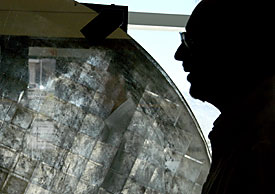 |
|
DANIELLE MALOTT/Arizona Daily Wildcat
|
Robert McMillan, associate research specialist for the Spacewatch Project explains how one of the large mirrors works inside of a telescope yesterday.
|
|
By Joshua Sills
Arizona Daily Wildcat
Wednesday May 7, 2003
A member of the UA community turned 80 last month, but it may not be who, or what, one might expect.
It was the 36-inch telescope located on Kitt Peak.
The telescope, which was dedicated April 23, 1923, is UA's oldest, and since its dedication, has helped many UA astronomers search the night sky.
"I discovered a trans-Neptunian object named Veruna (with the telescope). It has one of the largest orbits I've seen," said Robert McMillan, who uses the telescope four or five times a month.
McMillan, who is associate research specialist for the Spacewatch Project, explained the trans-Neptunian objects as those whose orbits are outside that of the planet Neptune.
McMillan's findings are just a part of telescope's history.
President Calvin Coolidge attended its dedication ceremony in 1923, and a book containing his signature is still on display at the site.
"He just signed his name Calvin Coolidge, Vermont. He was known for being humble," McMillan said.
The telescope was originally owned and operated from the Steward Observatory on campus. It was relocated to Kitt Peak in 1962.
Twenty years later, the Steward Observatory gave control of the telescope to the Spacewatch program, which still oversees it today.
Now Spacewatch is the only group to use the telescope. The group primarily focuses on searching for Near Earth Objects, such as asteroids and other debris floating through space.
"It's too specialized for anyone besides Spacewatch to use," McMillan said.
Throughout the telescope's history, April 23 has been an eventful day. Last year Spacewatch installed a new system on the telescope that makes it faster when scanning for near-Earth objects.
According to McMillan the team changed the telescope from a single detector to four charge couple devices.
"The new mosaic of CCDs allows us to scan the sky nine times faster," McMillan said.
The upgrade has proved to be helpful for Spacewatch, McMillan said. In the first 25 nights of observation, observers saw six near-Earth objects.
Other recent accomplishments by the team include senior research specialist Joe Montani's naming of two minor planets he discovered. They were discovered in 1997 and named in 2002, through the old telescope.
The concept for Spacewatch began in the 1950s when Planetary Sciences Professor Tom Gehrels was a student. He started out using photographs to observe objects in space, but began using electronic devices when they became available in the 70s.
"It made it 100 times better," Gehrels said.
Gehrels met with McMillan in the late Î70s, and they began seeking funding in 1980.

